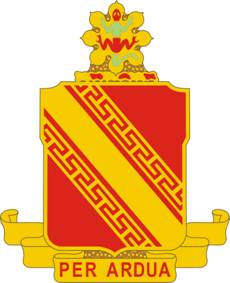
The 4th Air Defense Artillery Regiment was constituted 1 June 1821 in the Regular Army as the 4th Regiment of Artillery and organized from new and existing units with headquarters at Pensacola, Florida. As a result of the division of the Artillery Corps into Coast and Field Artillery units, the Regiment was broken up 13 February 1901, and its elements reorganized and redesignated as separate numbered companies and batteries of the Artillery Corps.
The 11th Coast Artillery was a coast artillery regiment in the United States Army, first constituted in the Regular Army on 27 February 1924. It primarily served as the Regular Army component of the Harbor Defenses of Long Island Sound, New York from 1924 through 1944, when it was relieved and disbanded as part of an Army-wide reorganization.

The 7th Air Defense Artillery Regiment is an air defense artillery regiment of the United States Army, first constituted in the Regular Army as the 7th Regiment of Artillery on 8 March 1898. The 6th and 7th U.S. Artillery Regiments were constituted on 8 March 1898, three weeks after the explosion of USS Maine in Havana, Cuba on 15 February 1898, as the United States' declaration of war on Spain and commencement of the Spanish–American War seemed imminent.

The 44th Air Defense Artillery Regiment is an Air Defense Artillery regiment of the United States Army, first constituted in 1918 in the Regular Army during World War I. During World War II the unit served as the 54th Coast Artillery Regiment

The 55th Air Defense Artillery Regiment was an Air Defense Artillery regiment of the United States Army that was first constituted in 1917 in the Regular Army. It was previously the 55th Artillery, U.S. Army Coast Artillery Corps. (CAC)

The 6th Air Defense Artillery Regiment is an air defense artillery regiment in the United States Army, first formed in 1898 as the 6th Regiment of Artillery. The 6th and 7th U.S. Artillery Regiments were constituted on 8 March 1898, three weeks after the explosion of the USS Maine in Havana, Cuba on 15 February 1898, as the United States' declaration of war on Spain and commencement of the Spanish–American War seemed imminent.
The 92nd Coast Artillery Regiment was a Coast Artillery Corps regiment in the United States Army, part of the Philippine Scouts. It was a Regular Army unit composed primarily of Filipino enlisted men and US officers.
The 91st Coast Artillery Regiment was a Coast Artillery Corps regiment in the United States Army, part of the Philippine Scouts. It was a Regular Army unit composed primarily of Filipino enlisted men and US officers.
The 10th Coast Artillery Regiment was a Coast Artillery regiment in the United States Army. It primarily served as the Regular Army coast artillery component of the Harbor Defenses (HD) of Narragansett Bay, Rhode Island from 1924 through 1944, when it was relieved and disbanded as part of an Army-wide reorganization.
The 13th Coast Artillery Regiment was a Coast Artillery regiment in the United States Army. Elements of the regiment served during World War II in the Harbor Defenses of Pensacola, HD Key West, HD Galveston, HD Charleston, Temporary HD of New Orleans, and in Bora Bora in the South Pacific. The regiment was broken up and its elements redesignated on 31 August 1944 as part of an Army-wide reorganization.
The 61st Air Defense Artillery Regiment is an air defense artillery regiment in the United States Army. The lineages of some of the units that initially made up the 61st Artillery (CAC) give the regiment's 1st Battalion campaign credit for the War of 1812.
The 62nd Air Defense Artillery Regiment is an Air Defense Artillery regiment in the United States Army. The lineages of some of the units that have been part of the 62nd Air Defense Artillery and its predecessors give the regiment campaign credit for the War of 1812.
The 63rd Coast Artillery was a Coast Artillery regiment in the United States Army. It was deactivated and broken up in 1943, with its last descendants inactivated in 1958.
The 64th Coast Artillery was a Coast Artillery regiment in the United States Army.

The 197th Field Artillery Regiment is a regiment in the New Hampshire Army National Guard.
The 202nd Air Defense Artillery was an antiaircraft regiment of the Illinois Army National Guard.
The 18th Coast Artillery Regiment was a Coast Artillery regiment in the United States Army. It was the Regular Army component of the Harbor Defenses of the Columbia, replacing the 3rd Coast Artillery there. Other elements of the regiment were also part of the Harbor Defenses of San Francisco. The regiment was active from 1940 until withdrawn in April 1944 and inactivated the following month as part of an Army-wide reorganization.
The 19th Coast Artillery Regiment was a Coast Artillery regiment in the United States Army. It was the garrison of the Harbor Defenses of San Diego, replacing the 3rd Coast Artillery there. The regiment was active from 1940 until broken up into battalions and partially inactivated in October 1944 as part of an Army-wide reorganization.
The 20th Coast Artillery Regiment was a Coast Artillery regiment in the United States Army. It was the garrison of the Harbor Defenses of Galveston in World War II, with Battery C deployed to Tongatapu, Tonga March-August 1942. Until the 20th CA (HD) was fully activated in April 1942, HD Galveston was also garrisoned by the 265th Coast Artillery (HD) Regiment and elements of the 50th Coast Artillery (TD) Regiment. The 20th CA Regiment was active from August 1940 until broken up and partly deactivated in August 1944 as part of an Army-wide reorganization.
The 50th Coast Artillery Regiment was a Coast Artillery Corps regiment in the Regular Army. It was mobilized in World War I and World War II.







